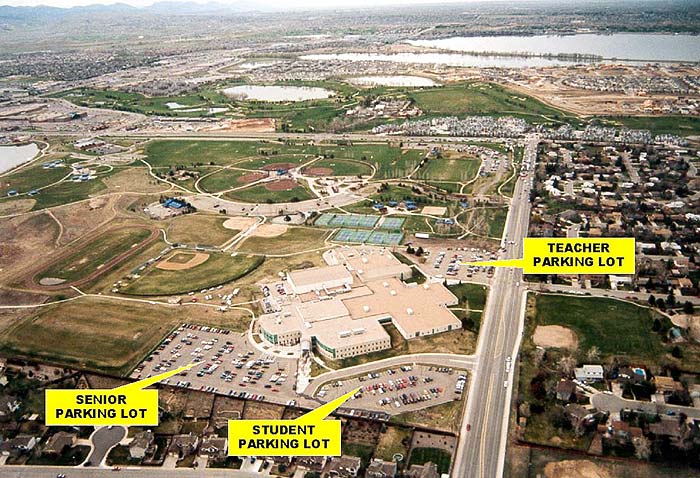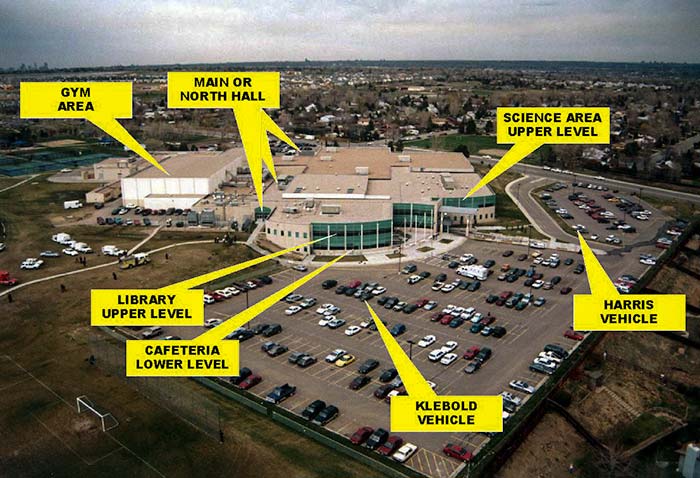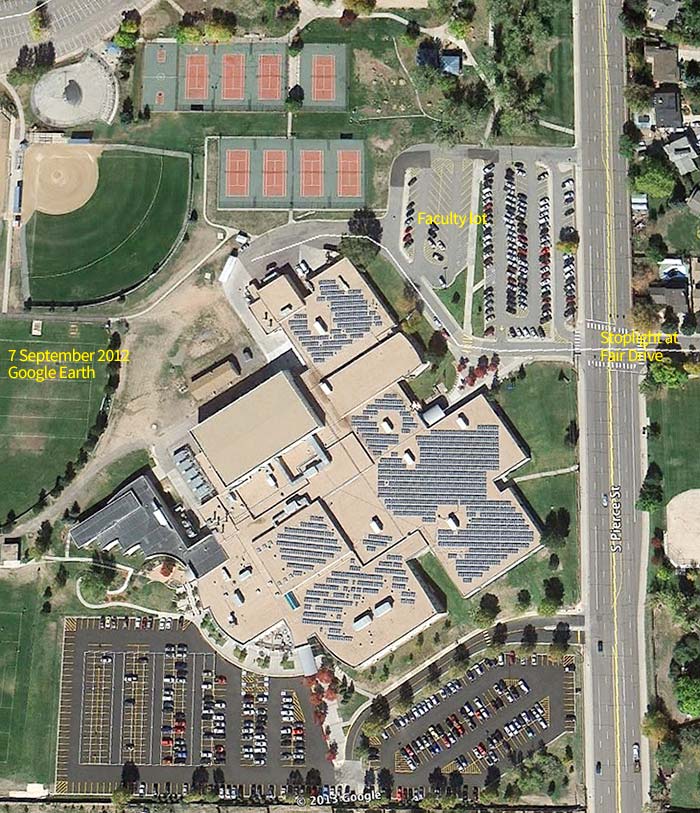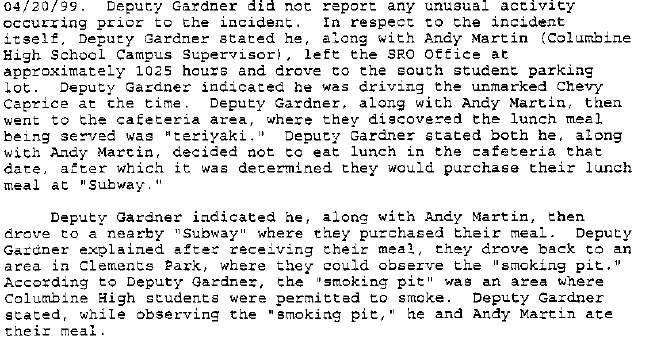
Where was Columbine’s school resource officer (SRO), Neil Gardner, while Eric Harris and Dylan Klebold were killing and wounding students and faculty? He was on campus, arriving at the scene of the shooting eight minutes eight minutes after Harris and Klebold carried bombs into the cafeteria. Could he have prevented the killings had he been in the cafeteria, where he usually ate lunch, from the beginning? I believe the answer is “no,” and explain why in the following paragraphs.
Adam Lanza’s Sandy Hook massacre lasted 10–15 minutes. At Columbine, Harris’ and Klebold’s massacre lasted 47 minutes while they moved around the school shooting students and teachers and detonating pipe bombs. Understanding Columbine requires getting into the weeds. I begin with a note on sources, present maps, follow with descriptions of (a) the Harris-Klebold plot and actions and (b) Gardner’s whereabouts that day, and conclude with a brief analysis.
Entering “Columbine High School massacre,” with the quotes, into Google returns 662,000 hits. Most are incidental to the subject. Others are more useful: the Wikipedia, news reports, magazine articles, books, and official reports from government entities that investigated the incident. The latter documents — in particular, the files released by the Jefferson County Sheriff’s Office (JCSO), and The Report of Governor Bill Owens’ Columbine Review Commission, both available on schoolshooters.info — are the most useful, but not infallible.
I looked for, but did not expect to find, a verbatim transcript, hopefully with accompanying videotape, of Neil Gardner’s 26 April 1999 debriefing by the Arvada, CO, police department. Perhaps one exists, but I’m still looking. I did, however, find Arvada Detective R. Boatright’s 9-page summary of his interview with Gardner (witnessed by Officer Brian Thompson). Although a secondary instead of primary source, Boatright’s summary, coupled with an incident narrative written by JCSO, helps establish most of Gardner’s movements that day. I’ve broken out Boatright’s interview summary as a separate PDF for your convenience (the JCSO documents are in 1,000-page PDFs). Denver area reporter Dave Cullen’s book, Columbine, written 10 years after the killings, provides valuable information, especially on JCSO’s attempt to cover-up its knowing of Eric Harris’ dangerous tendencies a year before the shootings. One major defect of Cullen’s book: he does not employ ellipses when shortening quotes (to me, a reporter’ doing that is a firing offense).
Published timelines should be viewed with caution. They were reconstructed from the tapes of first responder dispatchers. One timeline in the JCSO files bears a handwritten instructing the reader to add four minutes to the times. The intervals between the times probably are correct, but the actual times may be off by four minutes from official Mountain Time.




Just under 2,000 students attended Columbine High School in 1999. Located southwest of Denver, CO, in unincorporated Columbine in Jefferson County, the campus occupied approximately 20 acres on the southeast corner of a half-section containing Clement Park, to the north and west of the school, and Johnson Reservoir.
Columbine students Eric Harris, 18, and Dylan Klebold, 17, spent a year planning and procuring the weaponry for the attack. Troubled young men, at least one a textbook sociopath, they were no strangers to the criminal justice system. Settling scores with individuals was not their motive. They were, Governor Owens’ commission reported:
…determined to kill as many teachers and fellow students as possible, first, by planting and detonating two 20-pound propane bombs in the school cafeteria and then by shooting survivors fleeing the inferno they hoped to create. When their explosive devices failed to ignite, the two approached the school and killed one student and seriously wounded a second as they ate their lunches on the grass. They then entered the school building and began firing at students leaving the school cafeteria, wounding five students and deliberately executing one of them.
Klebold entered the school cafeteria briefly but did not fire his weapon inside; he returned outside the building and fired at students near the school parking lot, wounding one of them seriously. Meanwhile, a number of students, two school custodians, and at least one teacher fled to the cafeteria from which, in turn, many either fled from the building or climbed stairs to the second-story library; one teacher and a student were wounded when Harris fired a rifle at them through the school’s double glass doors. Emergency calls were made to the 911 number, and teachers urged students in the library to take cover under the tables. Klebold and Harris reentered the building and fired at students in the main hallway and hallway outside the library, wounding one. They also detonated or left for later detonation a number of pipe bombs. Encountering a teacher, Dave Sanders, they seriously wounded him with a shotgun blast. Sanders bled to death from his wounds before medical assistance was provided more than three hours afterwards.
About 15 minutes into their onslaught, the two entered the library where 56 students, two teachers and two library employees had sought concealment. Within seven-and-a-half minutes, Klebold and Harris killed 10 students and seriously wounded a number of other persons by rifle and shotgun fire; they detonated pipe bombs, although without inflicting severe wounds. Several students were deliberately killed execution-style. Klebold and Harris fired at police from library windows and received return fire. They left the library and moved to the science wing, where they shot at fleeing students. After returning briefly to the cafeteria, the two perpetrators tried again to explode by gunfire the two propane bombs they had carried earlier into the cafeteria, without success, but managed to detonate smaller bombs, one of which was attached to a container of flammable liquid. The resulting firebomb activated the cafeteria sprinkler system, and soon thereafter the sprinkler and fire alarm systems were activated throughout the school building.
The final moments of the perpetrators’ lives have not been clearly tracked. Apparently they moved into the office area on the second floor, and then returned to the cafeteria. A surveillance video camera captured their movements there: they seemed to survey the damage to the cafeteria and police activities in the school parking area. From there they went back to the library and exchanged gunfire from ivthe library windows with police who were protecting paramedics rescuing students wounded outside the school building. At about 12:08 p.m., or 47 minutes after the two had commenced their assault, the two turned their weapons on themselves and committed suicide, having left behind them a trail of 13 dead (12 students and one teacher) and many wounded persons. Because the response teams outside the school building were unaware of their deaths, it required several more hours before officers could secure the building, obtain medical attention for the wounded, and collect the dead. [Executive Summary, pages i–iv]
Harris carried a Hi-Point 995 semi-automatic carbine chambered for 9mm Parabellum ammunition. Klebold carried a semi-automatic TEC-DC9M pistol firing the same round. Both had short barreled shotguns, knives, and bombs.
Neil Gardner, 44, a deputy with the Jefferson County Sheriff’s Office, was a 15-year veteran of police work in the spring of 1999, and finishing his second year as the school resource officer (SRO) at Columbine.
Certified as a bicycle patrol officer, he was wearing black pants and a bright yellow polo shirt that day, driving a blue unmarked Chevy Caprice patrol car, equipped with a school two-way radio, and armed with a .45 caliber Sig Sauer P220 semi-automatic pistol. He had prescription glasses and sunglasses, but was wearing non-prescription sunglasses when he exchanged fire with Harris. (If his prescription corrected for presbyopia, his shooting vision probably didn’t suffer from not wearing his glasses. If it corrected for astigmatism, not wearing his glasses might have diminished his visual acuity.)
His duties, Boatright reported, extended beyond the high school:
Provides law enforcement functions in and around Columbine High School, also functions as liaison between the school and surrounding community. Deputy Gardner also utilized the Bike Patrol as part of the service he provided to Columbine High Schol and the surrounding community (to in clued Clements Park).
Note: Deputy Garnder is called upon to respond to calls for service outside of the Columbine High School area, depending on manpower allocations. In addition, Deputy Gardner rotates back to a patrol function when school is not in session.
The teriayki wild card. Gardner normally ate lunch in the school's cafeteria. But on 20 April, Boatright reported, he looked at the menu, saw teriyaki, and decided to eat elsewhere:

Where did Gardner park his car? In Columbine, Dave Cullen describes the smokers’ pit as “… a ten-by-eight grass rectangle cordoned off by telephone-pole logs just past the parking lot, just beyond the school grounds.” The parking lot where Gardner and Martin ate lunch, according to JCSO’s narrative, was “…near the school’s tennis courts….” Cullen reports “They ate their sandwiches in gardner’s squad car, in the faculty lot beside the smokers’ pit on the opposite [north] side of the school.” The faculty lot is adjacent to the tennis courts.
Cullen’s book and Boatright’s summary need to be reconciled. Either Gardner was in Clement Park or he was not. Cullen’s description of the smokers’ pit is more detailed than Boatright’s, and the location he provides for it is more precise than Boatright’s. In the notes to his book, Cullen reports having visited the pit many times over the years. Boatright, who worked in Arvada, was summarizing an interview of Gardner, conducted at Littleton’s Leawood Elementary just six days after the incident. I find Cullen’s report more credible. Boatright may have misunderstood Gardner, or have drawn the wrong conclusion from ambiguous information provided by Gardner. (This is why I prefer transcripts and video recording of interviews to summaries of the interviews.)
Gardner’s drive to the shooting scene. Whether in Clement Park, or in the faculty parking, the route to the shooting scene on the school’s south side was the same: a right turn onto southbound Pierce Street, through a stoplight at Pierce and W. Fair Drive, and a turn into the parking lots south of the school. From Boatright’s summary:

I believe that Gardner turned onto southbound Pierce from the northern entrance/exit of the faculty lot.
According to the governor’s commission report, Harris and Klebold were seen on the sidewalk outside the cafeteria at 1115, carrying duffle bags (page 26). The commission’s timeline reports that at 1121 Gardner received the radio message to come to the lunch room, and that he arrived in the parking lot outside the cafeteria two minutes later, at 1123, eight minutes after Harris and Klebold were spotted carrying the duffle bags. Gardner was the first law enforcement officer on the scene, remaining for the duration of the incident, and at one point exchanging fire with Harris (neither person was hit).